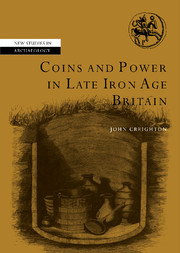Book contents
- Frontmatter
- Contents
- List of figures
- List of tables
- Preface
- Acknowledgements
- List of abbreviations
- Note on translations used
- Introduction
- 1 The Middle to Late Iron Age transition
- 2 Coin and the representation of individual authority
- 3 The Southern and Eastern kingdoms
- 4 Classical imagery and ideology in Britain
- 5 The location of Britain in the Roman world
- 6 Legends and language
- 7 Dynasties and identities
- 8 Conclusion and epilogue: from Britain to Britannia
- Appendix: A brief introduction to Iron Age coinage in Britain
- References
- Index of coin types
- General index
- NEW STUDIES IN ARCHAEOLOGY
Appendix: A brief introduction to Iron Age coinage in Britain
Published online by Cambridge University Press: 22 September 2009
- Frontmatter
- Contents
- List of figures
- List of tables
- Preface
- Acknowledgements
- List of abbreviations
- Note on translations used
- Introduction
- 1 The Middle to Late Iron Age transition
- 2 Coin and the representation of individual authority
- 3 The Southern and Eastern kingdoms
- 4 Classical imagery and ideology in Britain
- 5 The location of Britain in the Roman world
- 6 Legends and language
- 7 Dynasties and identities
- 8 Conclusion and epilogue: from Britain to Britannia
- Appendix: A brief introduction to Iron Age coinage in Britain
- References
- Index of coin types
- General index
- NEW STUDIES IN ARCHAEOLOGY
Summary
The most influential numismatist, whose work still dominates the field, was Derek Allen. Even a couple of decades after his death in 1975, the projects he initiated and contributed to were still being published (e.g. Hobbs 1996). His classic paper ‘The origins of coinage in Britain: a reappraisal’ (Allen 1960) put forward a simple and clear framework for describing and classifying the earliest gold coins in Britain. Within it he established a terminology which has stuck ever since. The six principal series of coins which he thought were imported into Britain from Gaul he termed Gallo-Belgic A–F. These he followed by a range of issues minted in Britain, which he termed British A–R. From these a series of regional coin series developed, which Allen gradually followed up and described in subsequent articles (e.g. Icenian coinage: Allen 1970). The names which Allen gave to the early gold coinage were simple and clear, even though subsequent work has suggested that some of the Gallo-Belgic issues were actually manufactured in Britain, and some of the British coin manufactured in Gaul.
Whilst Allen set up the interpretative framework, the principal catalogue which everyone used to identify coins was Mack (1953), which had replaced a set of old engravings in Evans (1864 and 1890). Mack was revised on a number of occasions; however, with the advent of metal detecting the discovery of new types of British coin increased enormously in the 1970s and 1980s.
- Type
- Chapter
- Information
- Coins and Power in Late Iron Age Britain , pp. 222 - 227Publisher: Cambridge University PressPrint publication year: 2000



